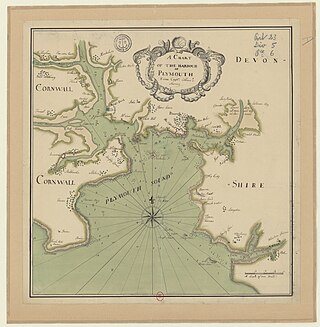Related Research Articles

A hull is the watertight body of a ship, boat, submarine, or flying boat. The hull may open at the top, or it may be fully or partially covered with a deck. Atop the deck may be a deckhouse and other superstructures, such as a funnel, derrick, or mast. The line where the hull meets the water surface is called the waterline.

A sailboat or sailing boat is a boat propelled partly or entirely by sails and is smaller than a sailing ship. Distinctions in what constitutes a sailing boat and ship vary by region and maritime culture.

The keel is the bottom-most longitudinal structural element on a watercraft. On some sailboats, it may have a hydrodynamic and counterbalancing purpose, as well. The laying of the keel is often the initial step in the construction of a ship. In the British and American shipbuilding traditions, this event marks the beginning date of a ship's construction.

Keelhauling is a form of punishment and potential execution once meted out to sailors at sea. The sailor was tied to a line looped beneath the vessel, thrown overboard on one side of the ship, and dragged under the ship's keel, either from one side of the ship to the other, or the length of the ship.

The draft or draught of a ship is a determined depth of the vessel below the waterline, measured vertically to its hull's lowest—its propellers, or keel, or other reference point.
The 1719 Establishment was a set of mandatory requirements governing the construction of all Royal Navy warships capable of carrying more than 20 naval long guns. It was designed to bring economies of scale through uniform vessel design, and ensure a degree of certainty about vessel capability once at sea, and was applied to all vessels from the first-rate to the fifth-rate. Once in effect, it superseded the 1706 Establishment, which had specified major dimensions for ships of the second-rate, third-rate and fourth-rate only.

The Sparrow-Hawk was a 'small pinnace' similar to the full-rigged pinnace Virginia that sailed for the English Colonies in June 1626. She is the earliest ship to participate in the first decades of English settlement in the New World to have survived to the present day.

John Day is the first recorded death in an accident with a submarine. Day was an English carpenter and wheelwright. With the financial support of Christopher Blake, an English gambler, Day built a wooden "diving chamber" without an engine. He attached his invention to the deck of a 50-ton sloop named the Maria, which Blake had purchased for £340. The sloop's hold contained 10 tons of ballast, and two 10-ton weights were attached beneath the keel which could be released from inside the diving chamber. An additional 20 tons of ballast would be loaded on the Maria after Day had been locked inside the diving chamber.

The Anti-Submarine Warfare Shallow Water Craft (ASW-SWC) corvettes, are a class of anti-submarine warfare (ASW) vessels currently being built for the Indian Navy, by Cochin Shipyard (CSL) and Garden Reach Shipbuilders & Engineers (GRSE). They were conceived as a replacement to the ageing Abhay-class corvettes of the Indian Navy, and are designed to undertake ASW duties – including subsurface surveillance in littoral waters, search-and-attack unit (SAU) missions and coordinated anti-submarine warfare operations with naval aircraft. They were also designed to provide secondary duties – including defense against intruding aircraft, minelaying and search-and-rescue (SAR).
Lady Thetis was a Cypriot passenger ship sunk for use as a recreational dive site in the Mediterranean Sea off Limassol, Cyprus.
The Hunter 376 is an American sailboat that was designed by the Hunter Design Team as a cruiser and first built in 1996.
The Hunter 39 is an American sailboat that was designed by Glenn Henderson as a cruiser and first built in 2009.
The Hunter 420 is an American sailboat that was designed by the Hunter Design Team as a cruiser and first built in 1998.
The Hunter 456 is an American sailboat that was designed by the Hunter Design Team as a cruiser and first built in 2003.
The Hunter 466 is an American sailboat that was designed by the Hunter Design Team as a cruiser and first built in 2002.
The Hunter HC 50 is an American sailboat that was designed by the Hunter Design Team as a "long distance express cruiser" and first built in 2000.
The Watkins 25, also known as the W25 and marketed as the Seawolf 25 from 1986, is an American trailerable sailboat that was designed by the Watkins Design Team and first built in 1983.
The Ericson 23-2 is an American trailerable sailboat that was designed by Bruce King as a cruiser and first built in 1975.
The ETAP 23 is a Belgian trailerable sailboat that was designed by Jacques de Ridder as a cruiser and first built in 1982.
The Santana 21 is an American trailerable sailboat that was designed by Seymour Paul as a lightweight racer-cruiser and first built in 1969.